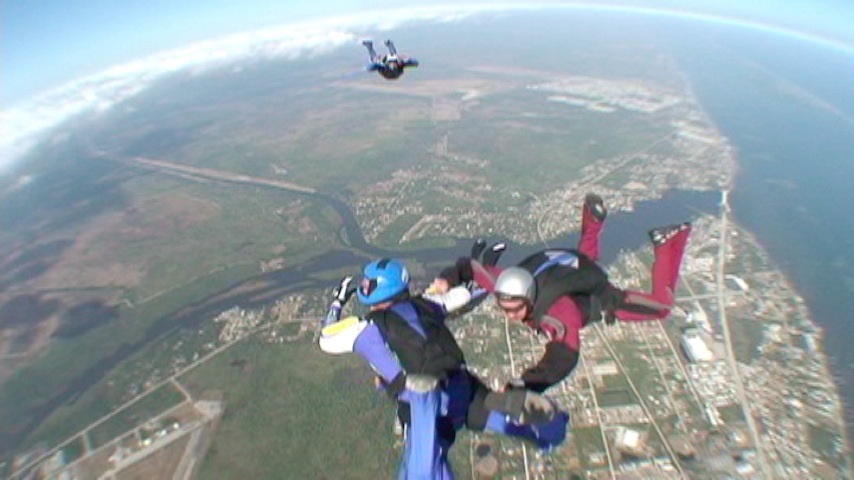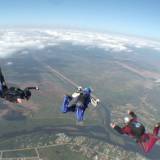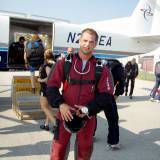-
Content
17 -
Joined
-
Last visited
Never -
Feedback
0%
Community Reputation
0 NeutralGear
-
Main Canopy Size
190
-
Reserve Canopy Size
193
-
AAD
Cypres 2
Jump Profile
-
Home DZ
Sebastian, FL
-
License
B
-
License Number
33709
-
Licensing Organization
USPA
-
Number of Jumps
200
-
Years in Sport
2
-
First Choice Discipline
Formation Skydiving
-
First Choice Discipline Jump Total
75
-
Second Choice Discipline
Freeflying
-
Second Choice Discipline Jump Total
125
-
Meeting the 200 jumps in 18 months timeline?
FireFlyer2009 replied to slackercruster's topic in Wing Suit Flying
Problem solved, wingsuiting is not for you. Jumping a wingsuit is similar to skydiving in a straight jacket, except the wingsuit moves you around the sky, so you also have to navigate at the same time. This is not the situation for a 'casual' jumper. If you want to be a 'casual' jumper, you can do that. Smart 'casual' jumpers will limit their activites to basic skydives with only one or two other people, will only jump in the best of weather conditions, and will seek re-current training from an instructor at the beginning of every season. Of course, there are stupid 'casual' jumpers who feel that even though they only have 60 jumps, they've been jumping for 4 years and have 'been around', so they can do whatever they want. Those guys don't last very long. Wingsuiting is pretty far up the skydiving mountain. If you want to be a 'part-timer' then by all means do so, but limit your activites to the bottom of the slope, where it's easy. If you want to ride the lift up to the top, you better have your shit together, and that means practice, currency and dedication. Cheers! I'm working hard to get another 40 jumps in before my FFC at the end of the summer...going to cost $1,500 and take a couple of months. Going from FF to Wings is a work in progress. Seems practicing exits as if you're in a suit and tracking dives, together with deployment procedures to develop muscle memory, have been the advice I've been given at my home DZ. I was also advised to take an advanced canopy course which I'm doing for the second time this weekend. Every new wing flyer I know says that they have made mistakes that have cost them a reserve ride or two right out the gate...I'm paying close attention! Blue Skies!!! -
The Good Samaritan Laws that are normally in place from state to state cover a person who is trying to help another person out in an emergency. If we didn't have these laws then nobody would help anyone when they needed it. I am not an attorney, however as a healthcare professional you are held to the standards set for whichever license or certifications you hold. The Good Samaritan Law still applies but is held to a higher standard than a non-healthcare professional. As a healthcare professional you are held to the standard of care that any other prudent person of the same classification. In order to have any negligence you would have to have acted in a manner that was not consistent with a person of the same standard of training and education. That's the basics of the Good Sam Law and Negligence. With that, simply because you had a class in CPR, First Aide, or AED training as a safety course doesn't and wouldn't qualify you as a healthcare professional in any sense of the word. If you take a safety class and they teach you not to move someone around because they could have a spinal injury, then you wouldn't go up and start moving their neck and asking them if it hurt. That would be negligence. On the other side...If you had a friend that was hurt and there was a possibility that he/she had a spinal injury, and you were trained in a safety course, you probably wouldn't allow the guy or girl to come up and start moving their neck around to see if it hurt. I believe that would explain the difference as to the Good SaM law and how it's applied. The degree of training that you might get form a basic trauma life support class for skydivers would simply give you the ability to act instead of hope. As well you could ease the pain and minimize the suffering of someone you know. Ultimately it's possible that you could save their life, keep them from further injury, and maybe be the difference between them being in a wheelchair for the rest of their lives or walking away. Blue Skies!!
-
That's good, sometimes CPR will work to save a life. Refreshers should be done annually because for some reason they change the procedures pretty frequently. Unfortunately CPR training isn't exactly the type of training for the 99% of skydiving injuries that happen. Traumatic full arrests have almost a 100% mortality rate. Basic First Aid and how it relates to skydiving injuries can be taught in a few hours. The certifications from American Heart for CPR & AED (automatic external defibrillator) are second and third to basic first aid for skydiving injuries. Blue Skies!!
-
Looks like more specific minimum training guidelines is probably overdue for our sport as it pertains to organized and certified DZ's. The minimum training requirements for Instructors needs to be expanded and more specific. Possibly an Emergency Response Plan for DZ's could prove to be of value. Thanks for all the PM's and info. Looking for at least 100 votes on the poll to get a good idea of interest. Please VOTE - Blue Skies!!
-
I definitely agree. With the accidents that are happening more regularly related to approaches, swoops, and landings it might be a good idea to know how to hold c-spine and immobilize someone on a spine board and open an airway. All these basic things should be reviewed and practiced annually. For anyone who doesn't have any medical training whatsoever, the type of training certification I am talking about would be no more difficult to learn then AFF. Making things simple and effective is the priority. If I were to have some sort of injury at the DZ I would definitely want someone to be able to help me out right away.
-
I was thinking of a certification program through American Heart Association (AHA) that would include first aide training, CPR, and AED (Automatic Defibrillator) training. Combining these certifications into a program tailored for skydivers and dropzone staff. No reason to limit training to staff only as everyone benefits from training, right? It's just inevitable that with any extreme sport comes injuries. Not having the training when you need it is an unfortunate drama that can be avoided. Being able to properly care for someone before rescue arrives can be the difference maker for sure. I've been a Paramedic for 22 years and always appreciate people with proper training that initiate care before I can arrive on scene. There are also many reasons to have an automatic defibrillator at the dropzone. They don't take much to operate and a person that needs rapid defibrillation isn't going to make it if they have to wait for a rescue unit to get there. As well everyone knows that if your brain is without oxygen for more than 5 minutes than you have brain damage. Being able to provide rescue breathing for someone who got knocked unconscious might save them the rest of their life with brain damage. I'm just trying to guage some interest level
-
I was wondering about the interest level about creating a medical training certification for dropzone staff. I am a 20 year firefighter/paramedic and have been recreational skydiving since 2009. All of the training is readily available for safe RW, CREW, FreeFly, Wingsuit, Coach/Instructor, but no certifications for training dropzone staff to respond to emergencies. I was thinking along the lines of a 16 hr. certification course that would provide classroom and hands on training to respond and provide initial treatment to injured skydivers. Looking for input and testing the waters of interest. Blue Skies!!
-
Skydiving and Traumatic Brain Injury
FireFlyer2009 replied to lanceav8r's topic in Safety and Training
haaaaa! funny visual! A good hard shell is perfect as long as it fits well and isn't too heavy. The last thing you want is a neck injury because of a bulky helmet. As long as the helmet is strong enough to protect you from a concussion injury then you're covered. If you're looking for protection from a skull fracture you're probably screwed anyway. Blue Skies! -
CX150, ContourHD 1080p, GoPROHD Comparison Footage
FireFlyer2009 replied to bomb420's topic in Photography and Video
Use the flat mount and mount it on top of your helmet. Tether the camera to the mount. Other solution is to buy the Xtreme Vu mount and never sweat losing your Countour: http://www.xvusa.com/index.html -
CX150, ContourHD 1080p, GoPROHD Comparison Footage
FireFlyer2009 replied to bomb420's topic in Photography and Video
I've been using a flat surface mount on top of my helmet after side mounting originally. My risers kept knocking the camera off on opening. On top of the helmet it's so lite that you don't even feel it. I was using the Full HD recording settings and on a couple of sitfly dives I got some wobble in the video with a couple of distortion lines horizontally. After looking up the 'wobble' on the vHoldr FAQ's it was noted that a shaky mount will cause this distortion. That's when I switched it to the top of my helmet. I am also going to use the setting that are at the top of this thread and switch to 720p/60fps. I HAVE FOUND THE PERFECT HELMET MOUNT FOR COUNTOURHD: [/url]http://www.xvusa.com/index.html[url] This is by far the best CountourHD Mounting solution i have found as well as a nice adapter to attach whatever camera lens you wish! Check it out. Blue Skies!!! -
I'm getting a demo this weekend and had not seen any more updates about the Pulse in awhile. Demo is a 190 and I'm jumping it at 1.3. Most the people I have talked to personally say they would buy one if they could find one used, but that's not possible. Any new reviews or comments on new ownership??? Blue Skies!
-
Passed out under canopy: watch those leg straps!
FireFlyer2009 replied to NWFlyer's topic in Safety and Training
The Valsalva manuever or corotid sinus massage is not to increase blood pressure! It is used to simulate the vagas nerve and slow down the heart rate...do not do this to yourself, EVER! Unless you are naked with a hot chick and you want to see what happens...but not during a sky dive! If you truly want to rule out the harness and leg straps being too tight, it's rather simple. Put the harness on and cinch it up just as you were wearing it. Wear it for as long as you were under canopy and have someone log your HR and B/P at each point that you think you had symptoms. If you repeat the similar symptoms, in anyway, it was the harness that stimulated this issue. That would not be the end of it for me. I would want an EKG with the harness on and the vital signs documented. Go to a local Fire Station and tell one of the Paramedics there what happened and what you want to do. They will hook you up, no problem! Get the information and if you find that you have vital signs that either show a decreased blood pressure of more than 10 points or an increase in your heart rate by more than 10 points, you need a cardiac workup from a cardiologist. Peace Brother!




